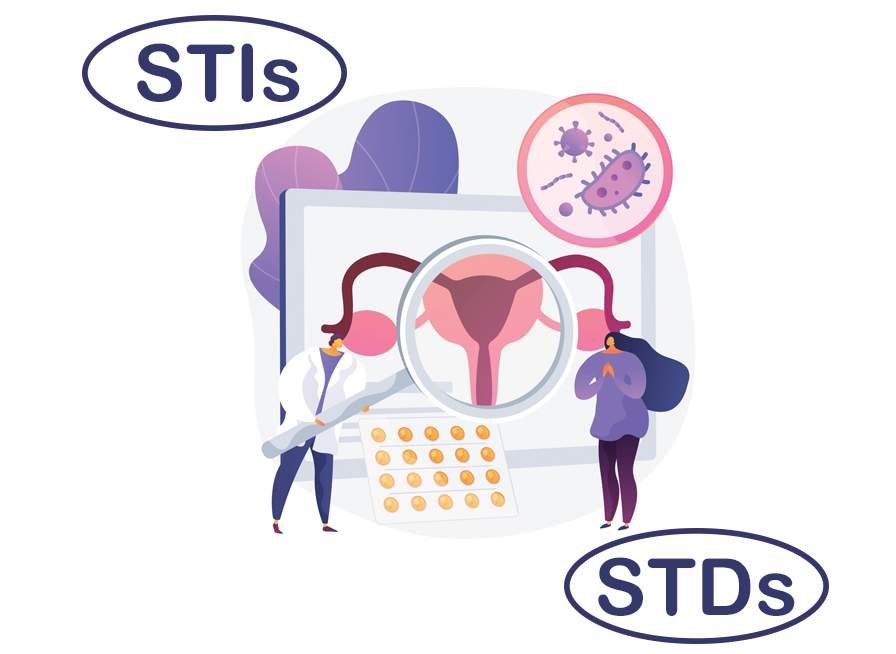What’s the difference between STIs and STDs? Are they the same, or are they two distinct entities? While the acronyms are very similar, an STI and STD are quite different in both definition and treatment.
Here, we explain what these acronyms stand for and how to know if you need to take preventative measures.
Types of Sexually Transmitted Infections
Sexually transmitted infections (STIs) are infections that you can get during sexual activity. They’re caused by viruses, bacteria, parasites, or fungi.
There are more than 20 different types of sexually transmitted infections, including genital herpes, human papillomavirus (HPV), HIV/AIDS, syphilis, and gonorrhea.
Some of these diseases may have no symptoms but many can cause serious health problems like infertility if left untreated. It’s important to understand how each infection is contracted to stay safe from all types of STIs.
What is an STI
Sexually transmitted infections, or STIs, are passed from person-to-person during sexual contact. For someone to contract an STI, they must have unprotected sex with someone who has an infection. Most sexually active adults will be exposed to some form of STI at some point in their lives.
Common STIs include chlamydia, gonorrhea, herpes, HPV (human papillomavirus), pubic lice (crabs), scabies, syphilis, and trichomoniasis. (1) What is an STD: A sexually transmitted disease, or STD, is any illness that can be spread by sexual activity.
While most people think of STDs as being spread through vaginal intercourse or anal sex, many common viral infections can also be spread through oral sex and even kissing.
The most common STDs include chlamydia, genital warts (HPV), herpes simplex virus type 1 (HSV-1), genital herpes simplex virus type 2 (HSV-2), human immunodeficiency virus/acquired immune deficiency syndrome(HIV/AIDS), human papillomavirus(HPV), hepatitis B, hepatitis C, and syphilis. (2)
Bacterial Vaginosis (BV)
BV is a common vaginal infection that can affect women at any age, although it’s most common in women of childbearing age. The cause of BV is the overgrowth of vaginal bacteria.
Women can get BV when certain good bacteria in their vagina (called Lactobacillus) are disrupted by several things like unprotected sex, use of an intrauterine device (IUD), douching, or use of spermicides. It often causes no symptoms, but if it does show up, it may include an increase in discharge or a change in odor that is similar to fish.
Chlamydia
An infection caused by chlamydia is transmitted through unprotected sex, direct contact with vaginal or rectal discharge, or an infected mother giving birth. The cervix (part of the female reproductive system that opens into the vagina) is most often affected by chlamydia.
It can cause both short-term (acute) and long-term (chronic) infections, as well as serious health problems like infertility in women. If a man has chlamydia, he could have a burning sensation when urinating and discharge from his penis.
If it goes untreated for too long, it can become penile cancer. Untreated chlamydia can also cause pelvic inflammatory disease (PID), which often leads to ectopic pregnancy or chronic pelvic pain in women.
Gonorrhea
If untreated, gonorrhea can lead to pelvic inflammatory disease (PID), which may lead to infertility in women. Left untreated, some types of gonorrhea can lead to life-threatening complications, including blindness or death. The causative organism is Neisseria gonorrhoeae.
Gonorrhea spreads from person to person through unprotected vaginal, oral, or anal sex with an infected partner. It is also spread by genital contact with an infected mother before birth or during delivery.
Babies born with gonorrhea can develop severe infections around their eyes and joints after birth if not treated promptly with antibiotics. Antibiotics have made it possible for most newborns who contract syphilis or chlamydia from their mothers at birth to be cured.
Hepatitis B and C (HBV, HCV)
Both hepatitis B (HBV) and hepatitis C (HCV) are viral infections of your liver. HBV is spread when blood, semen, or other body fluid containing HBV enters your body.
If you’ve been vaccinated against Hepatitis B or have been infected in the past, there is a very small risk of infection from unprotected sex with an HBV carrier.
You can contract Hepatitis C by coming in contact with infected blood. You can get it from sharing needles for injecting drugs; from getting tattooed by someone who doesn’t follow safe practices or sterile techniques; or through sexual activity if your partner has an open wound or if your partner has recently used IV drugs.
Human Immunodeficiency Virus (HIV)
HIV is a virus that causes AIDS. It can be spread from person to person through unprotected sexual contact, contaminated blood transfusions, or from mother to child during pregnancy, childbirth, or breastfeeding.
There is no cure for HIV/AIDS but it can be controlled with treatment. Although there is currently no cure for HIV/AIDS, advances in medicine have prolonged life expectancy rates.
Herpes Simplex Virus Type 1 (HSV-1) & Herpes Simplex Virus Type 2 (HSV-2)
There are two main viruses that people often refer to as herpes. However, they aren’t technically herpes! Herpes Simplex Virus Type 1 (HSV-1) – This is a virus that causes cold sores or fever blisters on your lips.
HSV-1 can also cause sores in your mouth and throat (known as fever blisters). It can be spread through kissing or sexual contact if you have an open sore. The HSV-1 virus may be what people commonly refer to as oral herpes or cold sores, although there are many other strains of viral herpes.
Herpes Simplex Virus Type 2 (HSV-2) – This is a virus that causes genital herpes.
HPV/Genital Warts
Genital warts are caused by human papillomavirus (HPV). It’s considered a sexually transmitted infection (STI), rather than a sexually transmitted disease (STD). In most cases, HPV goes away on its own, without any treatment.
Even though HPV does not appear to cause health problems for most people who have it, women with it have an increased risk of cervical cancer.
To help prevent HPV from turning into cancer, women should talk with their doctor about getting tested every three years for cervical changes and/or DNA testing. Treatment options are available if needed; however, there is no cure for HPV.
Trichomoniasis (Trich)
The more common name for trichomoniasis is trich. It’s caused by a single-celled protozoan called Trichomonas vaginalis. This parasite grows in warm, moist places like your vagina and mouth. Trich is spread through sexual contact with an infected partner.
If you have unprotected sex with someone who has trich, you’ll likely get it too. Symptoms can include itching, burning during urination, white or green discharge from your vagina, pain during sex, and swelling of your genitals or stomach area.
If left untreated for long periods trich can cause serious complications like pelvic inflammatory disease (PID). PID causes painful abdominal pain that can last months if not treated properly.



